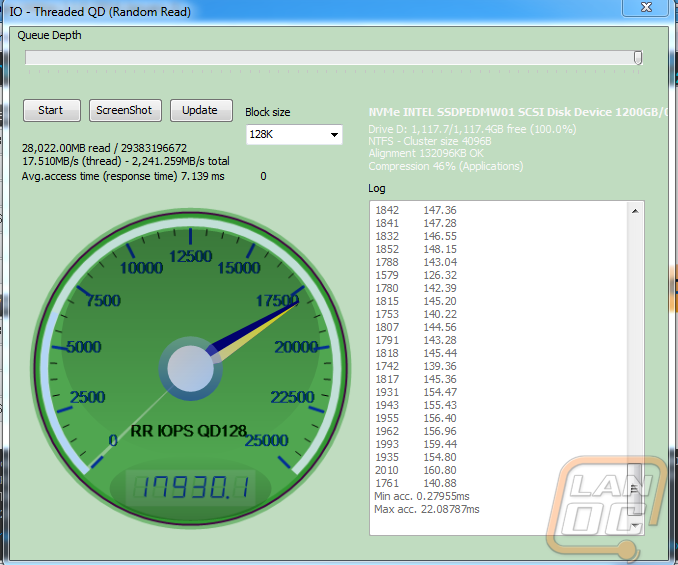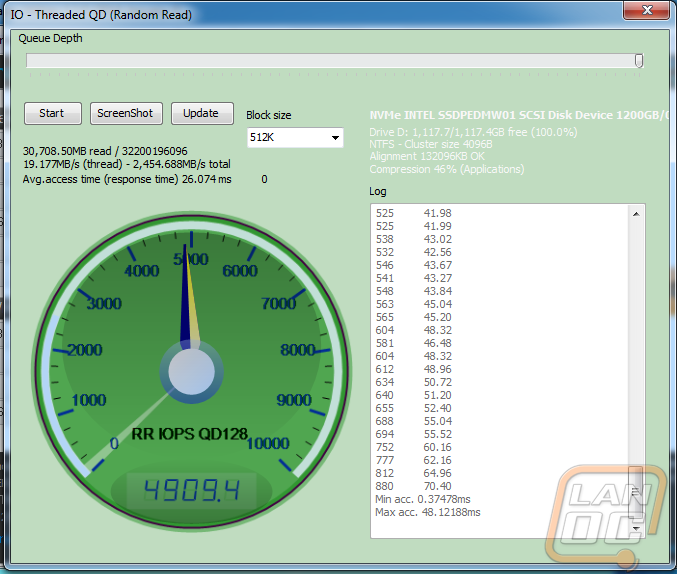Performance
The only way to find out how good the 750 Series really is of course is to run it through our benchmark suite. To help better show the performance regular readers will notice that I changed the way we display our graphs slightly and I also went through and added another benchmark and adjusted how we track our PCMark 8 benchmark as well. Before we get to those results, let’s take a look at the CrystalDiskMark results. One thing is very clear just from a quick glance of the results. The Intel drive is worlds apart from the standard SATA 3 SSDs that we have tested in the past. In results like the sequential test I saw almost 1700MB/s on the read speeds and over 1300MB/s on the write speeds. This isn’t exactly what Intel was promising, but I will get into that more later. Both are still extremely impressive results.


For AS SSD I changed up our graphs slightly as well. I stacked all three results to focus more on the overall speed of a drive rather than any one specific result. In a lot of cases one drive might be faster in one test but slower in the other two. This new way of looking at the results better show what drives are faster overall. That said, no shocks here, the Intel 750 Series stomped the competition, especially in the ISO test with a crazy .6 of a second file transfer. The next closest result took 2.21 seconds!

In our Passmark results the Intel drive once again blew away everything else tested. In just the file server result alone the 750 Series pulled 1623MB/s, more than any other drive did in all four tests combined.

I added PCMark 8 results to our storage reviews about a month ago but at the time I used the overall storage score. I was very disappointed that the overall storage score didn’t truly show the different between drives so from now on we will be using the storage bandwidth result. This is the overall bandwidth that the benchmark see’s over the entire hour+ long benchmark. In the case of the Intel 750 Series its results are twice as fast as the SATA competition. The 522.25MB/s result may seem slow, but it is in line with the results from the other drives. I suspect that the downtime in between each benchmark lowers this number in comparison to the drives potential sustained numbers.

In Anvil’s Storage Utilities I ran the 750 Series through 4K QD 16 read and write IOPS benchmarks. We can really see just how far ahead this drive is here. What I found interesting though is that the read speeds lag behind the write speeds in this test. Even so the read speed IOPS at a queue depth of 16 is still higher than the read and writes combined for most of the drives tested.

So by now you have to be wondering about the lack of any results showing the 2400MB/s read speed (we actually saw higher than the promised 120MB/s write speeds). Well Intel provided their own instructions with the drive on how they got their results. This included a full hour of drive prep in IOMeter and then running a full sequential benchmark at 128 Kb with a queue depth of 32. I can confirm that when testing using these instructions I actually saw a read speed of just over 2700MB/s and a write speed of over 1400MB/s, super impressive numbers!
The benchmark they provided is a fairly standard benchmark when looking at enterprise drives, but we don’t test a lot of enterprise drives so it was lacking in our benchmark suite. Well I’m not a fan of just taking a company’s test and including it in our benchmarks because this can sometimes lead to benchmarks that favor a specific manufacture. It did however expose a hole in our benchmarks, specifically we don’t test a rand of queue depths. So what I did is go back and retest a few of our recent drives and the Intel 750 Series using Anvil’s Storage Utilities Threaded QD benchmark. I ran both read and write benchmarks starting at a QD of 1, 2, 4, 8, 16, 32, 64, and 128(on the read only). Each test was run with a block size of 4K and this uses the same 46% compression that I run on our other Anvil benchmark.
So how did our new benchmark come out? Well with these results we can see that the Intel 750 Series handles a higher queue depth a LOT better than a standard SATA drive. This is partially due to the new NVMe connection that allows more parallel activity over the PCIe interface. This is why the 750 Series using an 18-channel controller where the most recent SATA SSD I tested uses 8. With these results we can also see why the write speeds were higher in the previously results. The 750 Series ramps up quicker on the writes but peaks where the read results keep going.


The results still don’t match the numbers promised by Intel but at closer. I did take go back and test the 750 with a 128QD with a block size of 128K and then 512K blocks as well. Here I did see 2,241 and 2,454 respectively on the read speeds. This drive is a monster!




